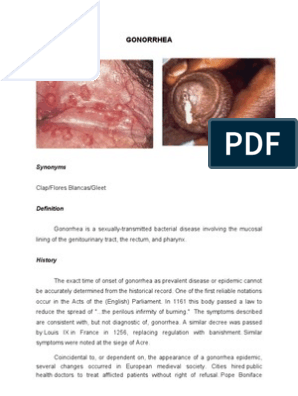0% found this document useful (0 votes)
151 views60 pagesGonorrhea: Neisseria Gonorrhoeae
The document outlines a curriculum for gonorrhea that includes 6 lessons covering the epidemiology, pathogenesis, clinical manifestations, diagnosis, patient management, and prevention of gonorrhea. It describes gonorrhea as a significant public health problem caused by the bacterium Neisseria gonorrhoeae that can infect the genital tract and other sites, with manifestations ranging from asymptomatic to pelvic inflammatory disease, epididymitis, and disseminated infection. The curriculum aims to educate medical professionals on diagnosing and treating gonorrhea according to CDC guidelines and preventing further spread.
Uploaded by
Rikki OkCopyright
© © All Rights Reserved
We take content rights seriously. If you suspect this is your content, claim it here.
Available Formats
Download as PPTX, PDF, TXT or read online on Scribd
0% found this document useful (0 votes)
151 views60 pagesGonorrhea: Neisseria Gonorrhoeae
The document outlines a curriculum for gonorrhea that includes 6 lessons covering the epidemiology, pathogenesis, clinical manifestations, diagnosis, patient management, and prevention of gonorrhea. It describes gonorrhea as a significant public health problem caused by the bacterium Neisseria gonorrhoeae that can infect the genital tract and other sites, with manifestations ranging from asymptomatic to pelvic inflammatory disease, epididymitis, and disseminated infection. The curriculum aims to educate medical professionals on diagnosing and treating gonorrhea according to CDC guidelines and preventing further spread.
Uploaded by
Rikki OkCopyright
© © All Rights Reserved
We take content rights seriously. If you suspect this is your content, claim it here.
Available Formats
Download as PPTX, PDF, TXT or read online on Scribd
/ 60























































































